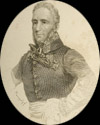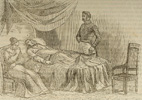19th Century´s militar history in the Basque Country
FRANCISCO ESPOZ MINA. (1781-1836)
 Espoz Mina was born in June 1781 to a humble farming family in Idocin (Navarre). During the French invasion, he enlisted as a volunteer in the guerrilla forces led by his nephew Javier Mina, the "Corso Terrestre de Navarra", in 1809. When his nephew was taken prisoner in March 1810, Espoz took over the command. He quickly gained acclaim as a guerrilla fighter for his tough character, shrewdness, cruelty, knowledge of the men and the territory, and ambition. He did not hesitate to shoot rivals and old friends to ensure discipline in the Navarre Division. Espoz kept the French army in check in Navarre, Aragón and Gipuzkoa, and in 1812, was appointed field marshal.
Espoz Mina was born in June 1781 to a humble farming family in Idocin (Navarre). During the French invasion, he enlisted as a volunteer in the guerrilla forces led by his nephew Javier Mina, the "Corso Terrestre de Navarra", in 1809. When his nephew was taken prisoner in March 1810, Espoz took over the command. He quickly gained acclaim as a guerrilla fighter for his tough character, shrewdness, cruelty, knowledge of the men and the territory, and ambition. He did not hesitate to shoot rivals and old friends to ensure discipline in the Navarre Division. Espoz kept the French army in check in Navarre, Aragón and Gipuzkoa, and in 1812, was appointed field marshal.
At the end of the war, he rebelled against Ferdinand VII by trying to reinstate the Constitution of Cádiz, which forced him into exile. The 1820 revolution allowed him to return to Spain to proclaim the Constitution in Santesteban in March of the same year. Just days afterwards, he entered Pamplona and was appointed commanding general of Navarre.
 In January 1821, he was appointed commanding general of Galicia, in which position he gained a republican reputation. At this time, he had already become a freemason. In July 1822, he was destined to fight the Realists in Catalonia. He became famous for his energy and unnecessary cruelty, evidenced by the total destruction of Castelfullit de Riubregós, a small realist village. When the French entered Spain to restore absolutism, he surrendered the fortress of Barcelona that was under his orders and went into exile in England.
In January 1821, he was appointed commanding general of Galicia, in which position he gained a republican reputation. At this time, he had already become a freemason. In July 1822, he was destined to fight the Realists in Catalonia. He became famous for his energy and unnecessary cruelty, evidenced by the total destruction of Castelfullit de Riubregós, a small realist village. When the French entered Spain to restore absolutism, he surrendered the fortress of Barcelona that was under his orders and went into exile in England.
He took part in numerous conspiracies hatched by emigrates in both England and France. After the French revolution in 1830, he considered that the time had come for a liberal invasion. In October, he led the famous expedition of Vera de Bidasoa, in which Gaspar Jauregi "The Shepherd" also took part. The expedition failed and ended up with the two in exile once again.
When the Carlist War broke out, he was protected by the amnesty decreed by the Regent Maria Christina. Shortly afterwards, he was named Viceroy of Navarre and in September 1834, he was put in charge of the struggle against the Carlists in the north. At this time, he was already suffering from a serious illness that would take him to his grave two years later. He was forced to fight Zumalacárregui at Larremiar, where he only just managed to escape and was almost taken prisoner. Exasperated by military failures and desperate to discover the cannons hidden by the Carlists in the outskirts of Lecaroz, in Baztán, he decreed the shooting of a number of villagers who refused to inform and ordered the village to be burnt, leaving only the church and three buildings standing. A few days later, he resigned from his post.
 In October 1835, he was appointed Capitán General (governor general) of Catalonia, though his illness meant that he spent more time in bed than in service. He gained some military success, eclipsed by measures such as the shooting of the mother of Cabrera, which added to his reputation for cruelty. He died in Barcelona in December 1836.
In October 1835, he was appointed Capitán General (governor general) of Catalonia, though his illness meant that he spent more time in bed than in service. He gained some military success, eclipsed by measures such as the shooting of the mother of Cabrera, which added to his reputation for cruelty. He died in Barcelona in December 1836.

